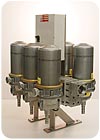
The air dryer system shown above uses a waterproof "molecular sieve" type desiccant bed combined with a patent pending pre-filter separator that removes oil.
According to the U.S. Department of Energy, compressed air is one of the most costly utilities in industry. It is typically produced by the expenditure of electrical energy in mechanical compressors, then distributed and regulated for use through expensive piping networks, regulators, valves and filters. Companies often spend tens or hundreds of thousands of dollars on compressed air equipment and operation, only to experience recurring problems such as moisture and dirt in their air lines.
In the atmosphere, air always contains some water in a vaporous form. The warmer the air, the greater the potential for that air to hold a larger amount of water. When air is mechanically compressed to perform some type of work, oil is often added from the compressor's lubrication system (crankcase, etc.). When the compressed air is released, it expands, cools and condenses the water vapor into water that often contains some of this oil, along with small particles of foreign matter picked up from the piping system. The combination of air and contaminants causes the compressed air system to lose efficiency, destroys the pipes and is certainly not good for most pneumatic machines and processes.
For some companies, the answer is an air dryer that uses a waterproof "molecular sieve" type desiccant bed, which is designed to provide low pressure dew points (-40ºF) compared to other types of dessicants. Combined with a patent pending pre-filter separator that removes oil, the system uses less electricity than a standard 75-watt light bulb. The scalable systems are rapidly being accepted as a reliable cost-effective solution whenever air is compressed for a number of commercial/industrial tasks.
For example, Banner Chevrolet in New Orleans, La., uses two large compressors outfitted with the air dryer/separator combination to paint six to 12 cars per day. "Prior to learning about and installing the air dryer system, we were getting ‘fisheyes' in paint jobs (drips due to water getting into the air lines of pneumatic spray guns). This was causing delays in getting our customer jobs out on a timely basis, plus increased costs due to having to sand out the fisheye and then repaint the job. With the New Orleans humidity and our outdoor tank location, we were forced to drain the tank twice a day - that is how much moisture we were fighting. We have had no more problems since we [installed the air dryer system] four years ago. I would say the system paid for itself the first month of operation," says Ronnie de St. Germain, body shop manager.
Other companies have also documented a rapid payback and low operating and maintenance costs with the air dryer system.
For more information, contact Thompson Equipment Co., Inc. (TECO), New Orleans, La., at (504) 833-6381, e-mail info@teco-inc.com or visit www.teco-inc.com.



